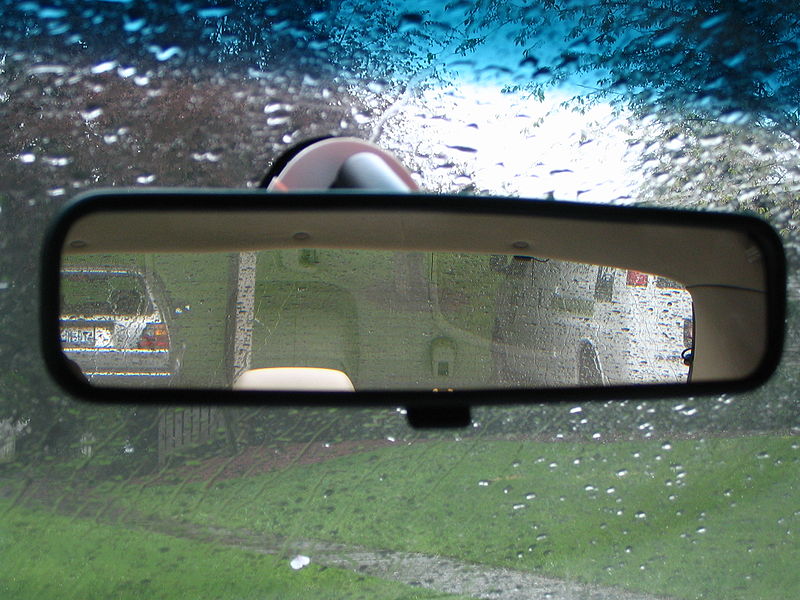‘We drive into the future using only our rear view mirror’
Marshall McLuhan
This morning I drove along Southend Seafront, on my way for a daily constitutional up the Thorpe Bay end and for a while I found myself positioned behind a Learner Driver – slowly but erratically making her way in the same direction ahead,as me.
It reminded myself that we all have to learn to drive. It’s not a gift we are born with, although some will have a more natural aptitude towards the act.
I realised that the one thing that really stuck out for me as I followed the driving school car, was seeing her eyes steadily looking into rear view mirror and thought that in today’s post it would be good to reflect on and take a look (if you pardon the pun) at the purpose and the need of utilising this important part of a cars anatomy.
Q. What is a rear view mirror?
A. A rear view mirror provides you with a true picture of what is behind you.
As a Driver, once you are settled in the position in preparation to drive, after you have adjusted your seat, hand and foot controls. It is time to make sure your mirrors are set correctly.
Adjusting the mirror, holding the top and bottom of the left hand side, your aim is to frame the rear window within the mirror, thus providing you with the clearest view of the traffic behind you, out of the rear window.
As a Driver you need to also be using your wing mirrors – these are convex and so give a wider angle and not a true picture. Objects will appear further away in your wing mirrors.
Q. Why is this important?
A. As a Driver you need to know what the traffic is doing behind you at all times.
1. e.g. If a vehicle is wanting to overtake you.
2. An emergency vehicle is speeding up behind you.
3. The speed of a car behind you, relative to yourself and in relation to other road users around. In an attempt to avoid rear end collisions.
The more information you have about the traffic surrounding you, then the better judgement and decisions you will be able to make, when and if you need to manoeuvre.
Fun Fact: In 1931 Mirrors were not even mentioned and Drivers were advised to sound their horn when overtaking.
http://www.gov.uk/government/publications/history-of-road-safety-and-the-driving-test
RULE 161 – Highway Code
Mirrors. All mirrors should be used effectively throughout your journey. You should
1. use your mirrors frequently so that you always know what is behind and to each side of you
2. use them in good time before you signal or change direction or speed
3. be aware that mirrors do not cover all areas and there will be blind spots.
You will need to look round and check.
Remember: Mirrors – Signal – Manoeuvre
http://www.gov.uk/using-the-road
If you are using your own car to sit the practical test, then you must ensure that you have a rear view mirror on the passenger seat side for the Examiner to use. The Examiner will then position this mirror accordingly. You will fail a Practical Test if the Examiner does not have a rear view mirror.
The Examiner will be focusing on the road and the traffic situation around them. What he/she will be looking for during your test is assessing your reactive responses to traffic as you take your driving test.
Depending on the traffic flow, a driver should be glancing in the rear view mirror roughly every 10 seconds. The Examiner will be watching for this.
Always check your mirrors in pairs.
For example:
If you are turning left – check your top mirror, followed by your left wing mirror
MOT:
This is the route of an MOT test for rear view mirrors.
Information |
Method of Inspection |
Reason for rejection |
| 1. Obligatory Rear view mirrors or indirect vision devices
2. Indirect vision devices(cameras) may replace mirrors on some vehicles, with the view to the rear displayed on a screen in the drivers cabin. Where such devices are fitted. Must have an exterior mirror fitted on both the offside and the nearside (‘a’ and ‘b’). |
1. Check the obligatory mirrors or indirect vision devices for presence and security. 2. Sit in the driver’s seat and check that each obligatory mirror or indirect vision device provides an adequate view to the rear. Note: It is not generally necessary to adjust mirrors or devices for this check. |
1.An obligatory mirror or indirect vision device missing or insecure. 2.An obligatory mirror or indirect vision device: a. obscured, damaged or deteriorated so that the view to the rear is seriously impaired b. does not provide an adequate view to the rear or is incapable of being adjusted to provide an adequate view. |
| Issue Date: 01 January 2012 | ||
Presence, condition and security
You are required to have one wing or door mirror fitted to you car. Most cars currently on UK roads will have two. One for each side of the vehicle. Each mirror will be inspected for security, condition of glass and to ensure they do not cause a danger, for example sharp edges.
Most vehicles will also have an internal rear view mirror fitted to the windscreen. This mirror is also required.
Driving in Adverse Weather Conditions:
Rule 229 in the Highway code states: make sure the mirrors are clear and the windows are demisted thoroughly.
Ensure you understand fully the function of your rear view mirrors.Have a chat with your A Pass 4 U Driving Instructor and they will explain the functions – such as anti-dazzle(newer vehicles) adjusting the mirror up to keep out the glare on older vehicles and the importance of positioning.


